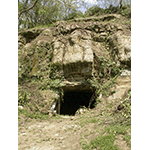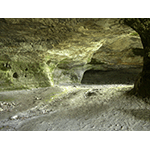Parco Archeologico "La cittą del tufo" - Abitato Rupestre Medievale di Vitozza ["City of Tufa" Archaeological Park - Medieval Rupestrian Town of Vitozza]
To venture among the lanes recessed in the tufaceous rock is today a rare and fascinating experience. And yet, for the Etruscans who dug these quarry roads, it was perhaps the commonest way to travel the area around Sorano and Pitigliano.
Tufa undisputedly dominates the landscape of this corner of southern Tuscany, and in the course of history, its inhabitants learned to wisely exploit this soft stone in order to excavate streets, tombs and even houses.
Vitozza is the monument and symbol of this civilisation. With its more than 200 caves, it is today one of the largest rupestrian centres of Central Italy. The town lived its moment of greatest fortune between the 13th and 14th century with the construction of the walls, church and fortress, the only buildings with elevations in town. All of the dwellings were indeed entirely excavated in tufa, and often have two or more storeys. Even the interior furnishings (niches, wardrobes, dining-tables) were meticulously carved into the rock bed.
Definitively abandoned in the 18th century, the city is today a "Pompeii in tufa", an archaeological park that can be easily visited, thanks to recent restoration that has also permitted the realisation of excellently outfitted footpaths.
Good walkers may also find it interesting to visit the remains of the walls of the Vitozza-Sorano aqueduct, built very soon after the Unification of Italy, and visible along the course of the Lente River.
****************************
Texts by Elena Fani
English translation by Victor Beard
Last update 14/gen/2008





